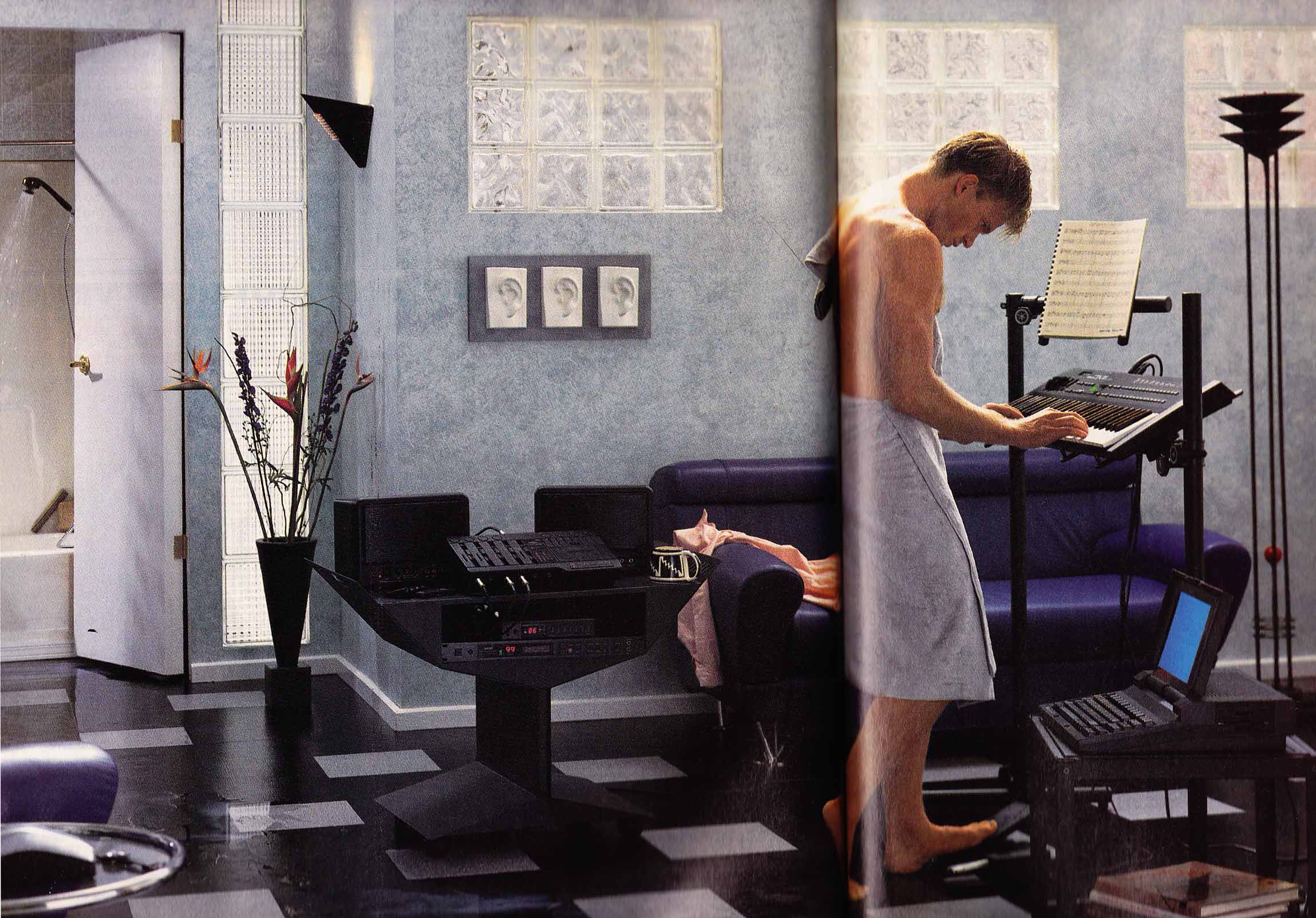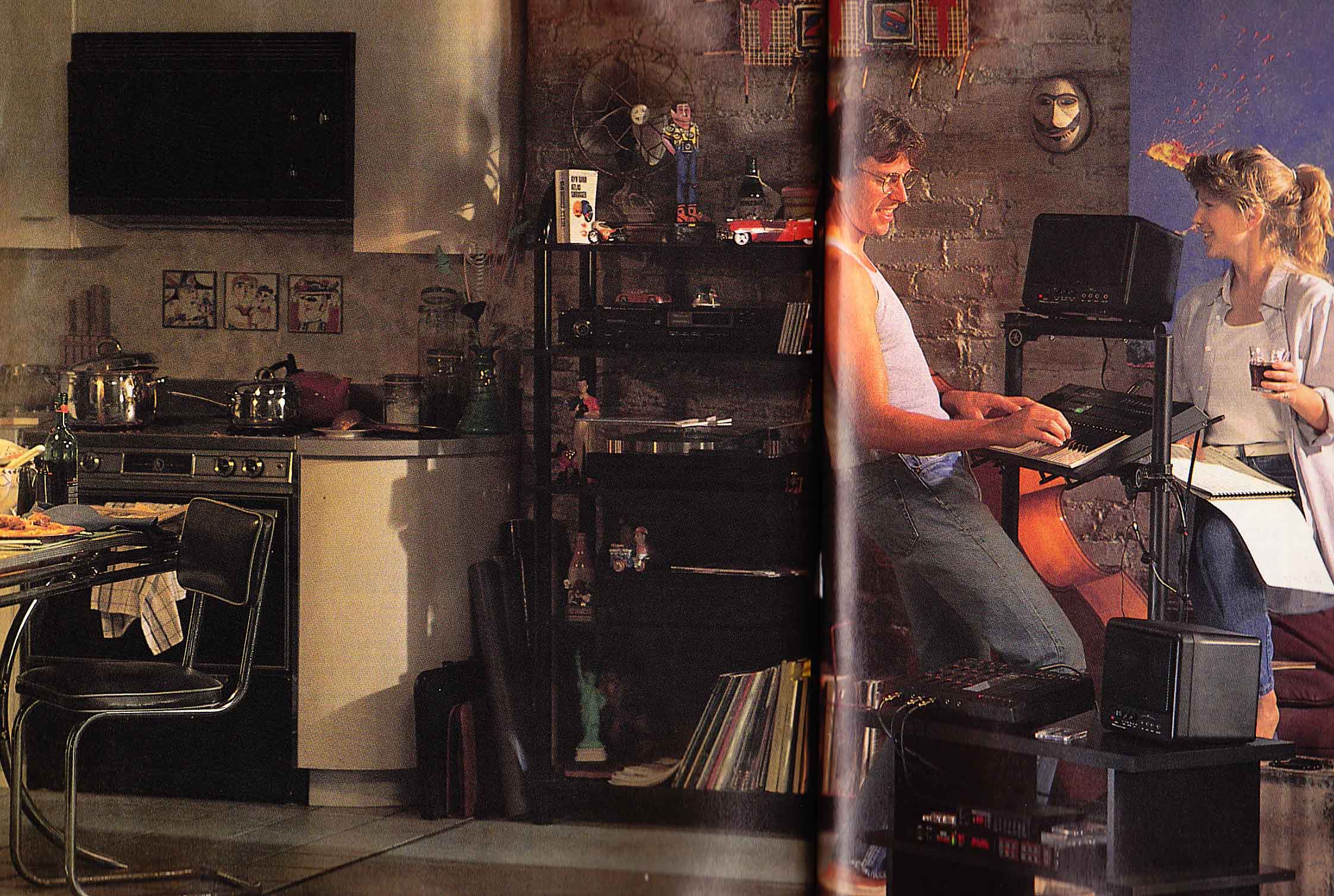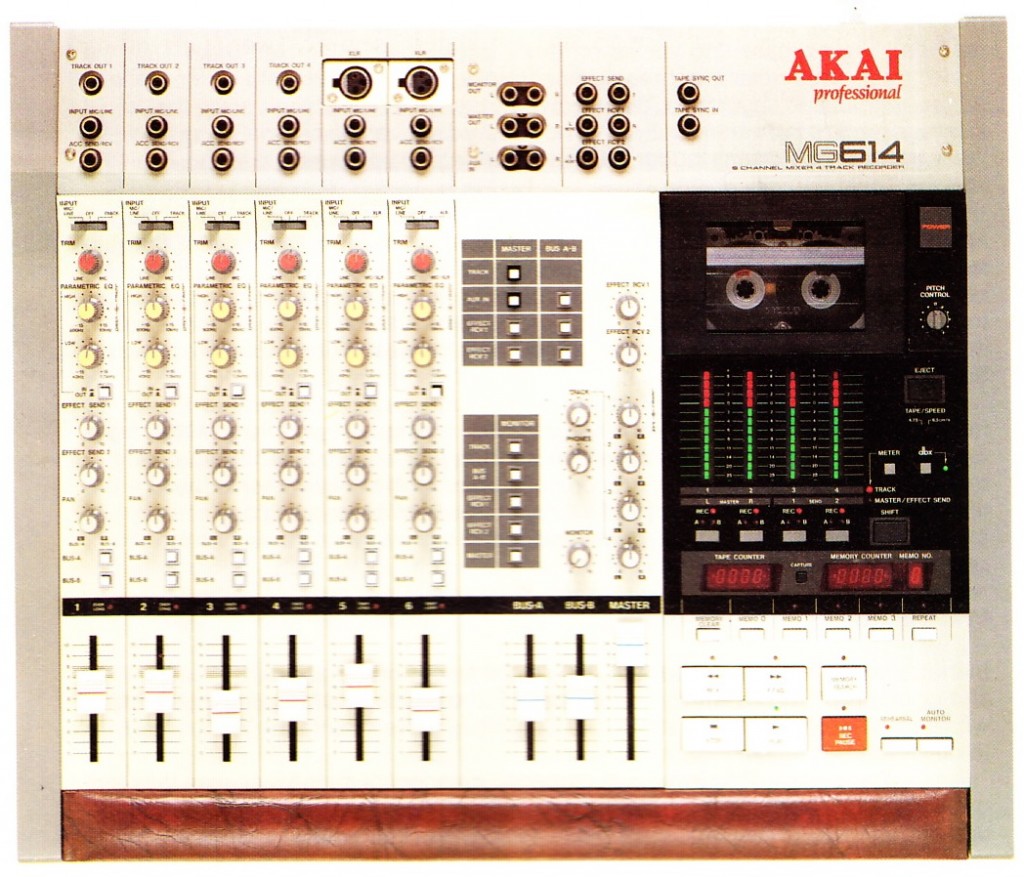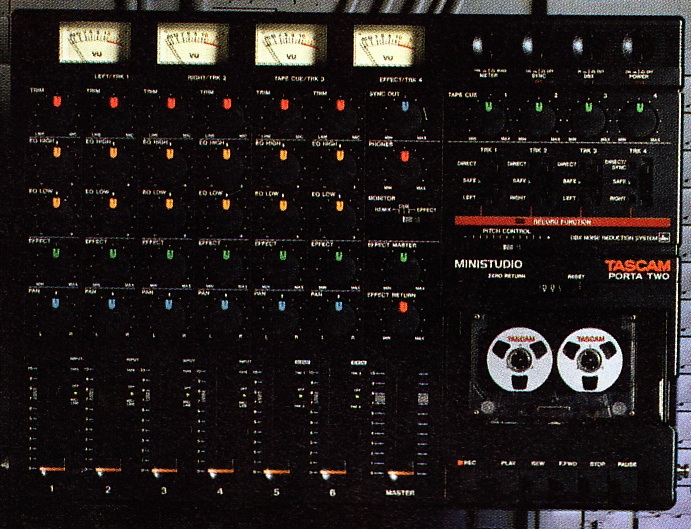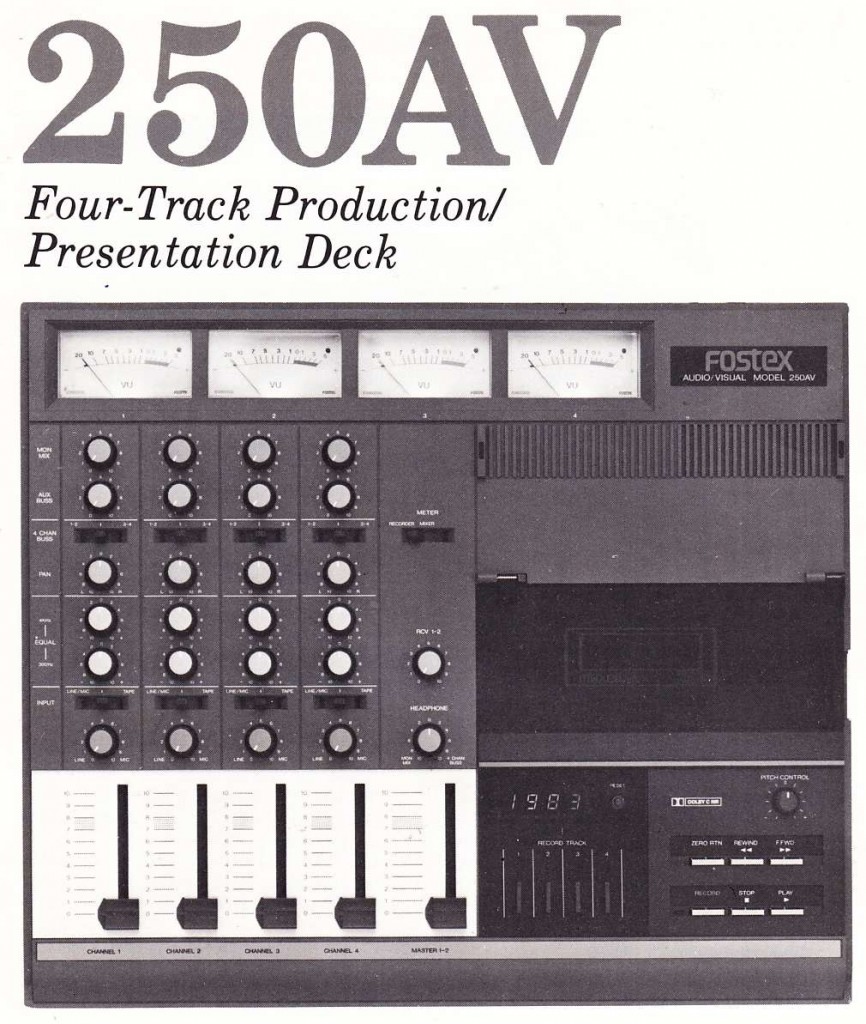Yamaha home-studio adverts circa 1989. Click on the images to expand.
Tag: the 4-track
The Introduction Of The 4-Track
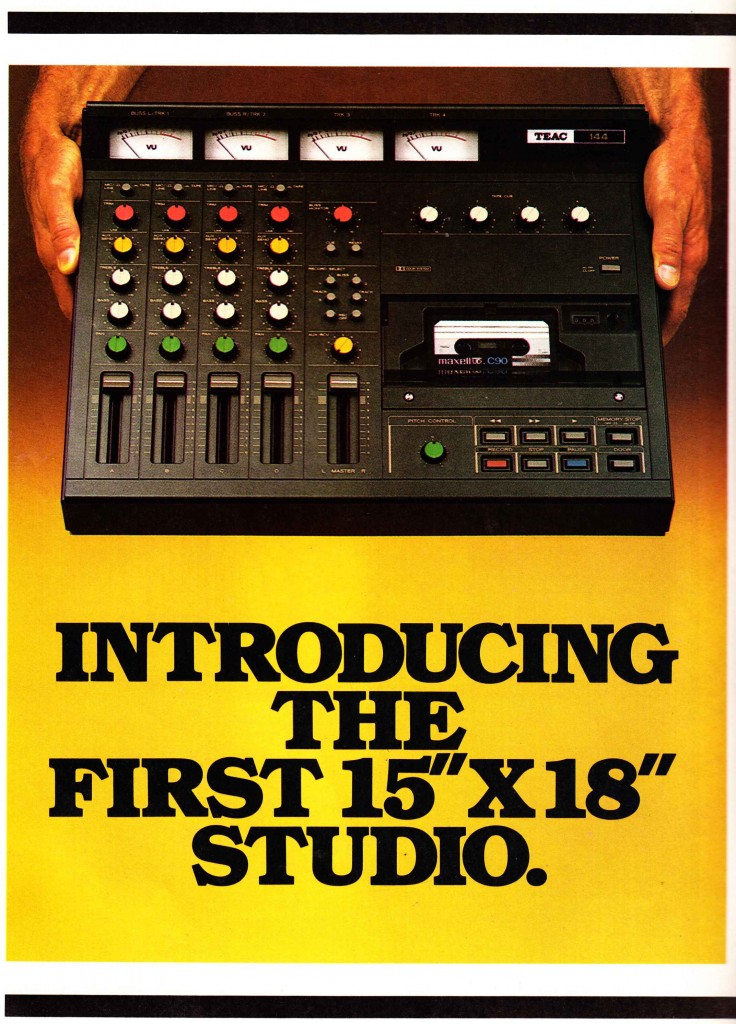
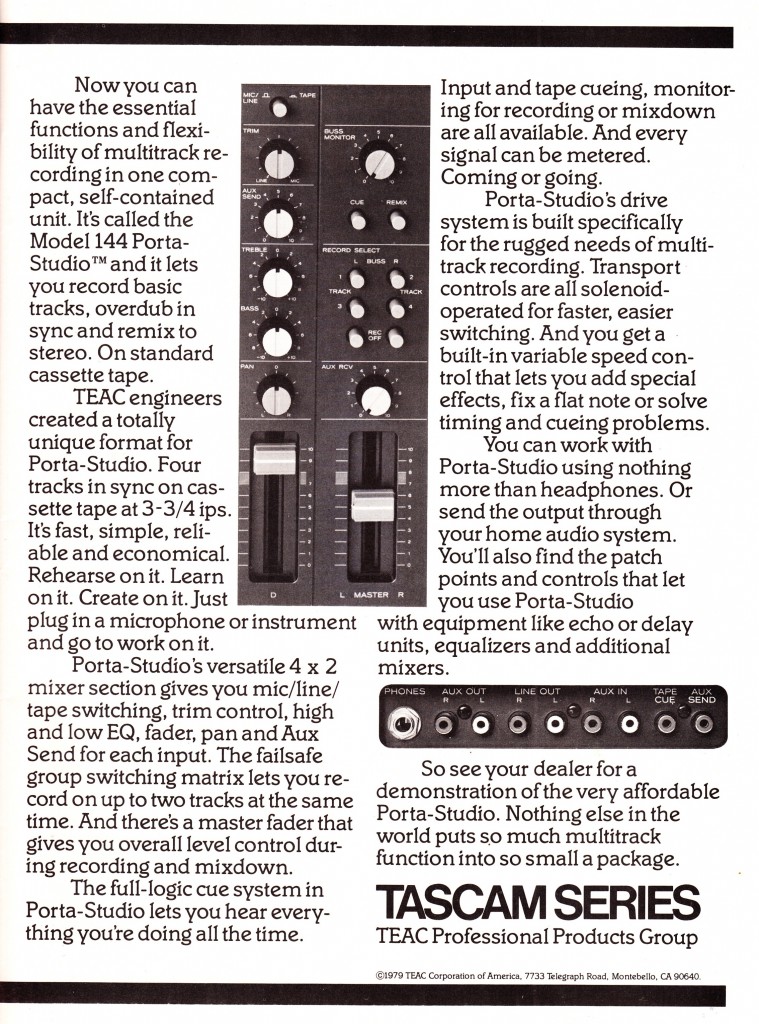 1979. Teac/TASCAM introduces the 144 Porta-Studio, the first four-track integrated tape machine/mixer. The first 4-track. A truly revolutionary product for many reasons, and the first of a product category that would have a profound effect on musical and audio aesthetics of the next 30 years. The two-page spread above is the advert that introduced this product to the public.
1979. Teac/TASCAM introduces the 144 Porta-Studio, the first four-track integrated tape machine/mixer. The first 4-track. A truly revolutionary product for many reasons, and the first of a product category that would have a profound effect on musical and audio aesthetics of the next 30 years. The two-page spread above is the advert that introduced this product to the public.
For all its importance, the 4-track was actually the lesser of two novel cassette-based products introduced by Japanese companies in 1979 which would have a profound global cultural impact. The other one? Click here if you haven’t guessed yet.
For an earlier discussion of the 144 and its legacy, click on this link.
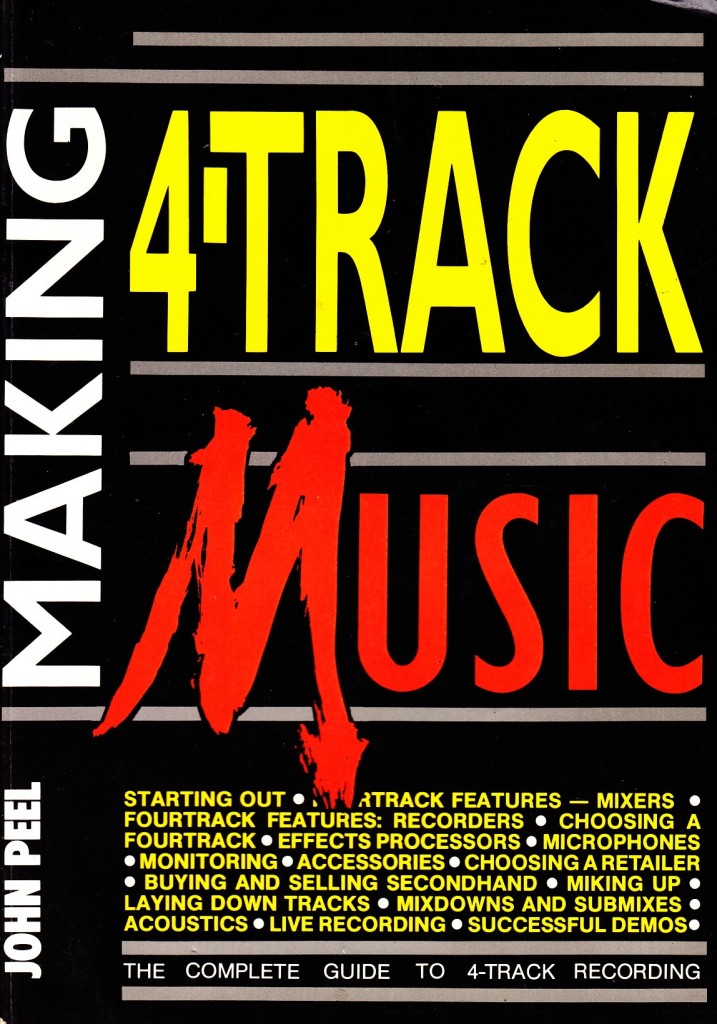 Download a seven-page scan of some interesting hardware on offer in “Making 4-Track Music,” Track Publishing 1987:
Download a seven-page scan of some interesting hardware on offer in “Making 4-Track Music,” Track Publishing 1987:
DOWNLOAD: 4trackMusic_JohnPeel
Includes advertisements for Yamaha MT2X, DX100, and RX17 drum machine; Akai MG614 four-track machine, Tascam Porta2 4-track, Fostex 160, the Boss Micro-Rack series (RDD-20 delay, RPS-10 pitch shifter, RCL-10 compressor, RRV-10 reverb, plus a ton more), and KORG’s multieffects.
*******
***
First-things-first: I have no idea if the ‘John Peel’ to whom this book is credited is the John Peel, he of legendary status as a DJ and taste-maker for an entire generation of rock and pop music. There is nothing whatsoever in this 98pp paperback volume (found in a Manchester OXFAM back in the early 00’s) that offers any indication pro or con. A third option would seem to be the ghostwriter scenario. Anyhow. “Making 4-Track Music” (h.f. “M4TM”) is an A5-sized paperback that attempts to introduce readers to the equipment and processes of using 4-track recorders.
The 4-track recorder, for those unfamiliar, is a category of product first introduced by the TASCAM corporation in 1979 with their model 144.
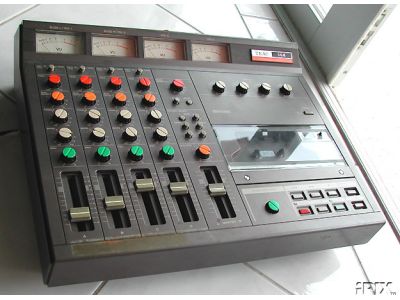 The 1979 TASCAM 144. Bruce Springsteen recorded his greatest album on this small plastic machine, believe-it-or-not. (Image source)
The 1979 TASCAM 144. Bruce Springsteen recorded his greatest album on this small plastic machine, believe-it-or-not. (Image source)
TASCAM already dominated the home-recording market with their 3440 1/4″ open reel tape recorder and the associated mixer-units that were marketed alongside it. These systems had a rather high cost of entry, though: they cost much more than a good used car. The 144 brought the basic concept of multi-track audio recording and mixing to a far lower price-point by using consumer cassette tape rather than 1/4″ open reel tape as the recording media, and by combining the audio-recording device and the audio-mixing apparatus into one single item. This made for a much more affordable system and it also made for easier use: no wires to hook up, no redundant or unnecessary features. Just the basic technology needed to record a performance and then add 3 additional performances in perfect synchronization while retaining the ability to control relative volumes and treatments of each track. With a creative user, the 4-track machine is capable of much more, but this is the basic concept.
“M4TM” covers all of this, and more; there is an explanation of the various recording and mixing features that the consumer would encounter in the marketplace, plus good treatment of the various types of additional processing equipment that a 4-track owner might like: digital time-based effects (delay, etc), compressors, gates, EQs., etc.
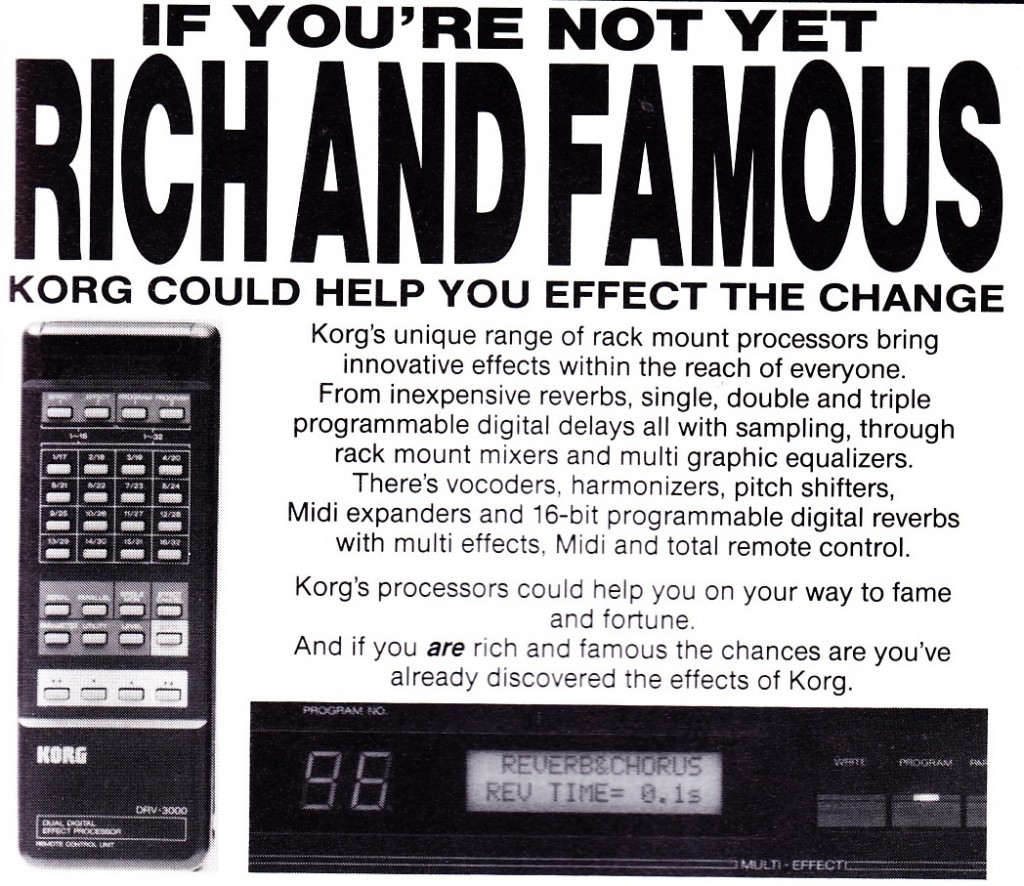 The aesthetics/art of making recordings is not really considered at all; there is a lot of talk about money, costs, (e.g., KORG’s above-depicted rainmaking) and the improved ‘recording quality’ that such expenditures can deliver but no mention of improving the presentation of songs and sonic ideas via any of this technology. Here’s a typical passage:
The aesthetics/art of making recordings is not really considered at all; there is a lot of talk about money, costs, (e.g., KORG’s above-depicted rainmaking) and the improved ‘recording quality’ that such expenditures can deliver but no mention of improving the presentation of songs and sonic ideas via any of this technology. Here’s a typical passage:
As someone who’s work is largely based on the commercial recording studio that I own and operate, I find it rather… alarming/offensive that the prime benefit of making a recording in a pro studio is the sound-quality, to extent that this benefit could be completely undone by several generations of tape-duplication. Jesus. I like to hope that I give my clients something more than a good signal-noise ratio and even frequency response. The passage above kind of makes it seem like it’s the EQUIPMENT in a studio that is doing the work, rather than the engineer… is this how most musicians feel about studios? Is this how I used to feel about studios, when I was 4-tracking at home at age 19?
(me at home, age 19: via Tascam Porta 03, Boss Micro -Rack effects): 07 The End
Furthermore, M4TM does not even entertain the aesthetic or artistic possibilities of all of this ‘4-track’ equipment. Rather, the emphasis is very much on ‘making-a-demo’ en route to possibly getting a ‘record deal,’ and all that this will entail (presumably the “Riches and Fame” for which you will have KORG to thank). The idea of possibly creating a compelling piece of artwork with this equipment is simply absent.
I wonder when this changed. By the time I started recording heavily on a four 4-track machine, a mere 8 years later (1995), musicians like Bill Callahan (aka SMOG) and Jeff Mangum (aka Neutral Milk Hotel) were already getting attention specifically as masters of 4-track recording. These guys did not appear too interested in making a ‘real record’ in a ‘pro studio.’ The 4-track medium, with its attendant tape hiss, awkward usage once you went past four tracks, and total absence of any sort of editing ability, was a huge part of the artwork that they created. Artwork that has truly endured.
I went to see Jeff Mangum perform last week here in CT. He did a solo set at the Shubert Theatre in New Haven. Jeff Mangum has not released a major album of his own in 13 years. The Shubert was nearly sold-out to it’s 1591 capacity.
Have a listen (above) to “Naomi” from Neutral Milk Hotel’s 1996 4-track masterpiece “On Avery Island.” Would these songs have been rendered any more compelling had they been tracked and mixed in a studio? I think we all know the answer to that… Ultimately, though, what Mangum’s solo-acoustic-gtr-and-voice performance at the Shubert last week demonstrated to me was more the fact that it probably honestly didn’t matter how he had made those seminal recordings: the songs themselves are so good and his voice and affect are so well-wrought that their properties can impress regardless of the presentation.
Perhaps I am reading into this all too much…perhaps my ideas and taste are a bit ‘off’ and therefore I have ‘niche’ values. Mangum seems, to me, to be a very straightforward singer/songwriter.. but perhaps my appreciation for artists like Jeff Mangum simply indicates that I have ‘weird’ taste, that I am out-of-step with ‘mainstream’ values… Goggle seems to think so. Here’s what you will see if you play a Neutral Milk Hotel song on Youtube:
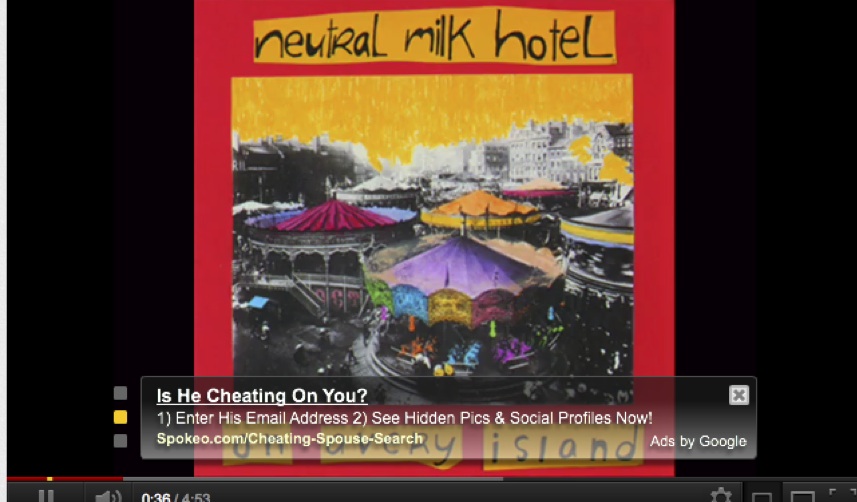
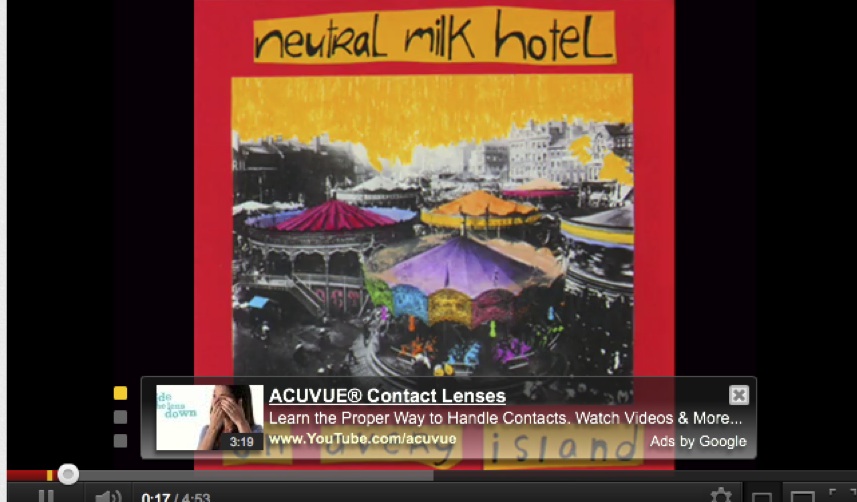


 Is your significant-other cheating on you? Maybe you need to lose those glasses: improve yr appeal? Fuck it, man, you’re a GEEK. Face it. Geek geek geek. Date another geek.
Is your significant-other cheating on you? Maybe you need to lose those glasses: improve yr appeal? Fuck it, man, you’re a GEEK. Face it. Geek geek geek. Date another geek.
I am so confused.
1987/2012: Maybe our John Peel simply wrote “M4TM” in a lost era, simple as that… an era when there still was a vigorous economic basis for the music-recording-industry and therefore the idea of recording music as INDUSTRY rather than EXPLOIT was still the dominant theme. It’s also interesting to consider that around the time of the first Neutral Milk Hotel album we also saw the introduction of Tape Op magazine, the first (that I am aware of…) widely-distributed publication that embraced the ethos of home-recording as a serious art form. And all of this happened just-in-time for the introduction of the first affordable DAWs (e.g., Pro Tools LE), which completely changed both the technique and the aesthetics of audio recording forever. You still need to be able to write a good song though. That much hasn’t changed.
Previous 4-track coverage on PS dot com:
Musician Magazine 1976 -1999
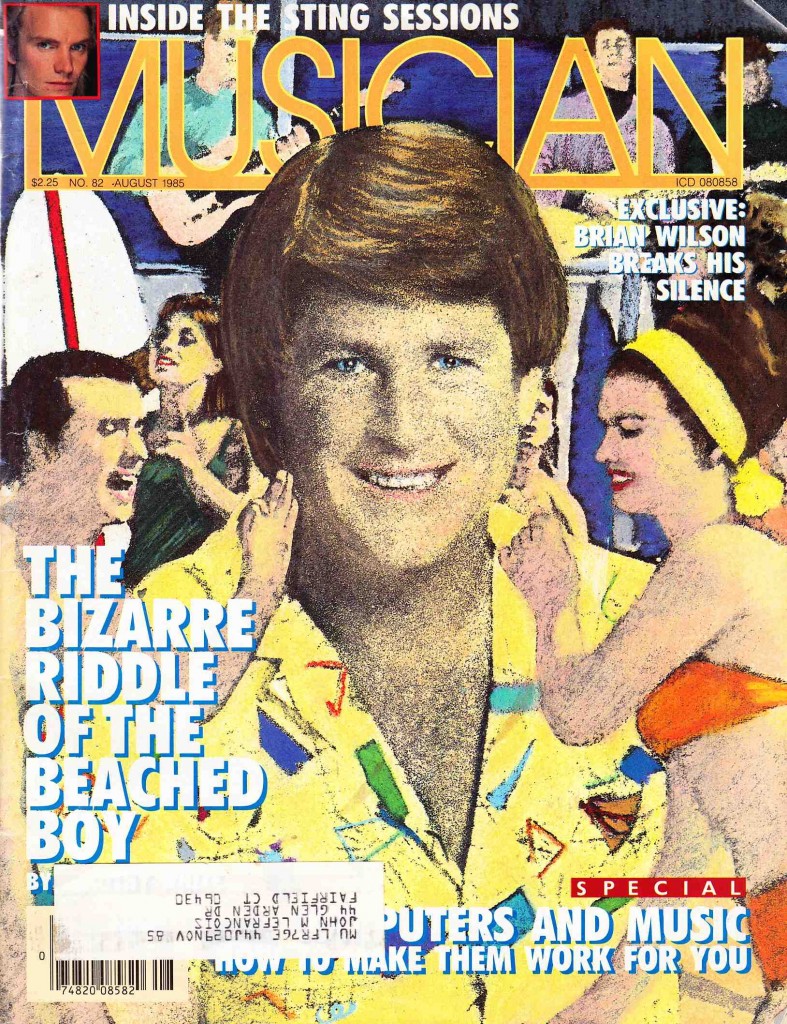 What if I told you that there was a music magazine which featured writers including rock-lit luminaries Lester Bangs and Cameron Crowe; exceptionally strong graphic design; and coverage of the most successful mainstream and most vital ‘underground’ artists of the day; all aimed not at music fans, but at musicians themselves. This publication was called, plainly, MUSICIAN, and it’s worth a look. From Wikipedia:
What if I told you that there was a music magazine which featured writers including rock-lit luminaries Lester Bangs and Cameron Crowe; exceptionally strong graphic design; and coverage of the most successful mainstream and most vital ‘underground’ artists of the day; all aimed not at music fans, but at musicians themselves. This publication was called, plainly, MUSICIAN, and it’s worth a look. From Wikipedia:
“Musician …was a monthly magazine that covered news and information about American popular music. Initially called “Music America”, it was founded in 1976 by Sam Holdsworth and Gordon Baird. (…) Subtitled “The Art, Business and Technology of Making Music,” it became known for its extended and thorough articles about the stars of rock music. “Musician” was not intended to be a fan magazine—the founders envisioned it as a publication about the musician’s craft, and as a result, it earned it the respect of people in the music business. As Holdsworth told an interviewer in 2003, the magazine “…created a level of trust that made the musicians feel they were talking with peers.” In that same article, he noted that “Musician” was also known for finding out the little things that the average magazine did not—such as why a musician chose a particular brand of instrument, or what was the inspiration for a certain song.”
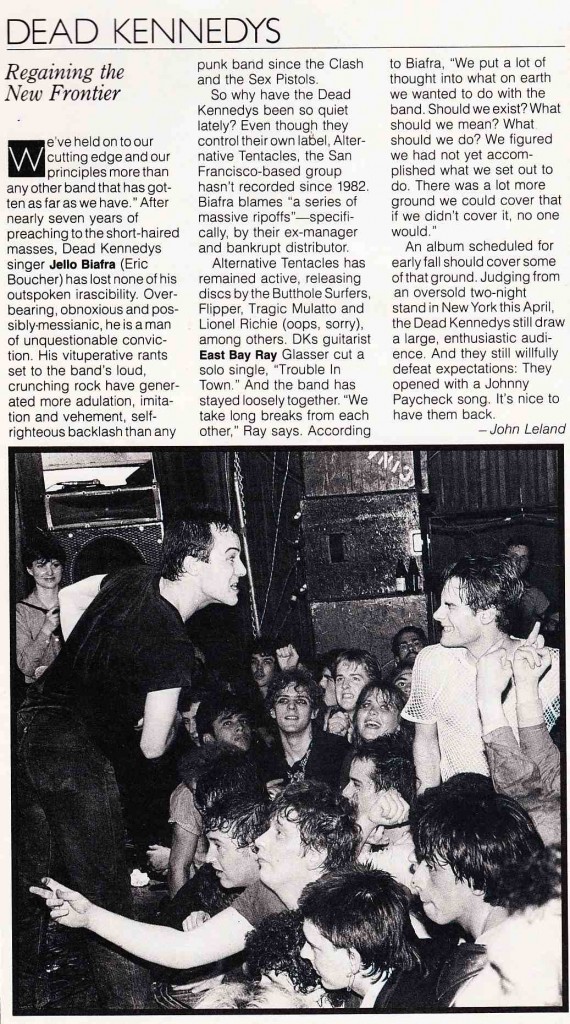 The Dead Kennedys in MUSICIAN, August 1985
The Dead Kennedys in MUSICIAN, August 1985
I have always been struck by how much more candid musicians are when speaking to musician-oriented publications rather than the popular or music-fan press. Old issues of Guitar Player magazine come to mind in this regard. MUSICIAN mag offers much of the same. The intended audience here is musicians, specifically; not recording engineers; but there is still some interesting historical bits for audio fans. If you chance upon a pile of old issues, pick em up. Some revealing advertising from the August 1985 issue:
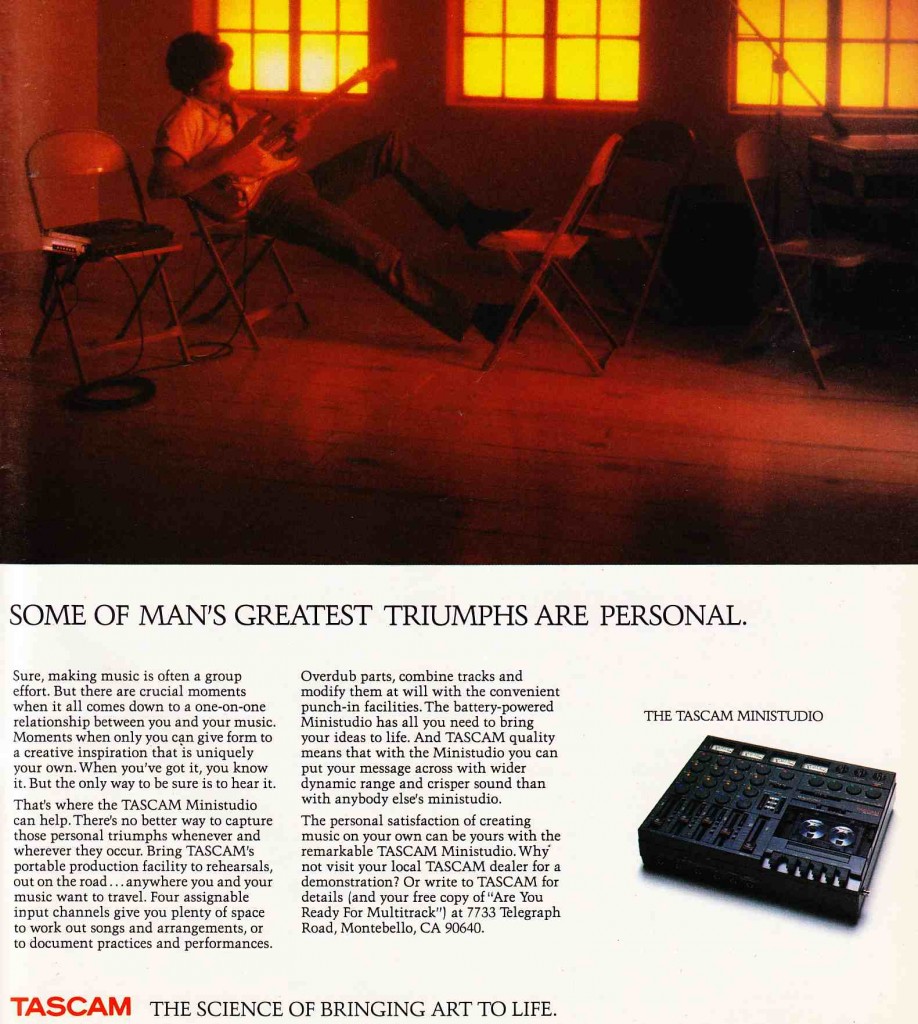 The Tascam Porta 01, which was a lower-priced alternative to their 144/244/246 cassette four-track. Note the light of God/Genius/Art streaming through the windows.
The Tascam Porta 01, which was a lower-priced alternative to their 144/244/246 cassette four-track. Note the light of God/Genius/Art streaming through the windows.
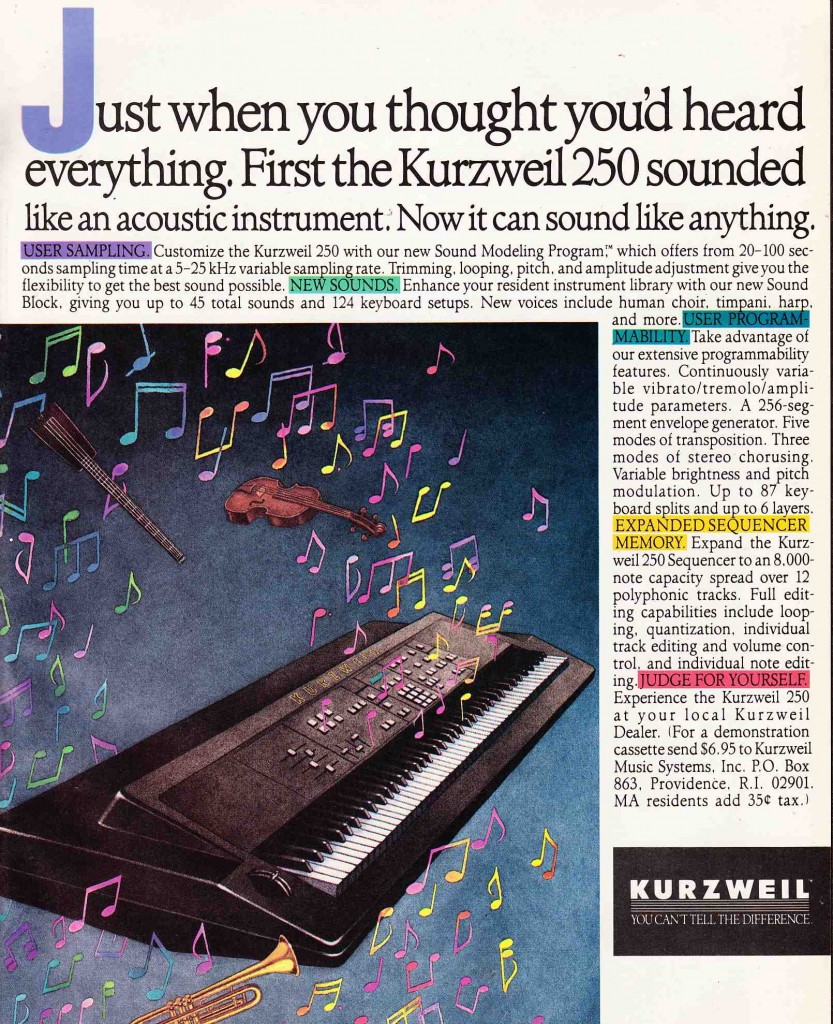 I studied composition at university, and we were taught on the Kurzwel K2500, which was a very high-end synth/sampler in 1995 (approx. $5000 loaded). This is spare change in comparison to the Kurzweil 250 of 1985 (pictured above), which sold for$14,000 – $16,000. That’s THIRTY ONE THOUSAND DOLLARS in today’s money. Good lord.
I studied composition at university, and we were taught on the Kurzwel K2500, which was a very high-end synth/sampler in 1995 (approx. $5000 loaded). This is spare change in comparison to the Kurzweil 250 of 1985 (pictured above), which sold for$14,000 – $16,000. That’s THIRTY ONE THOUSAND DOLLARS in today’s money. Good lord.
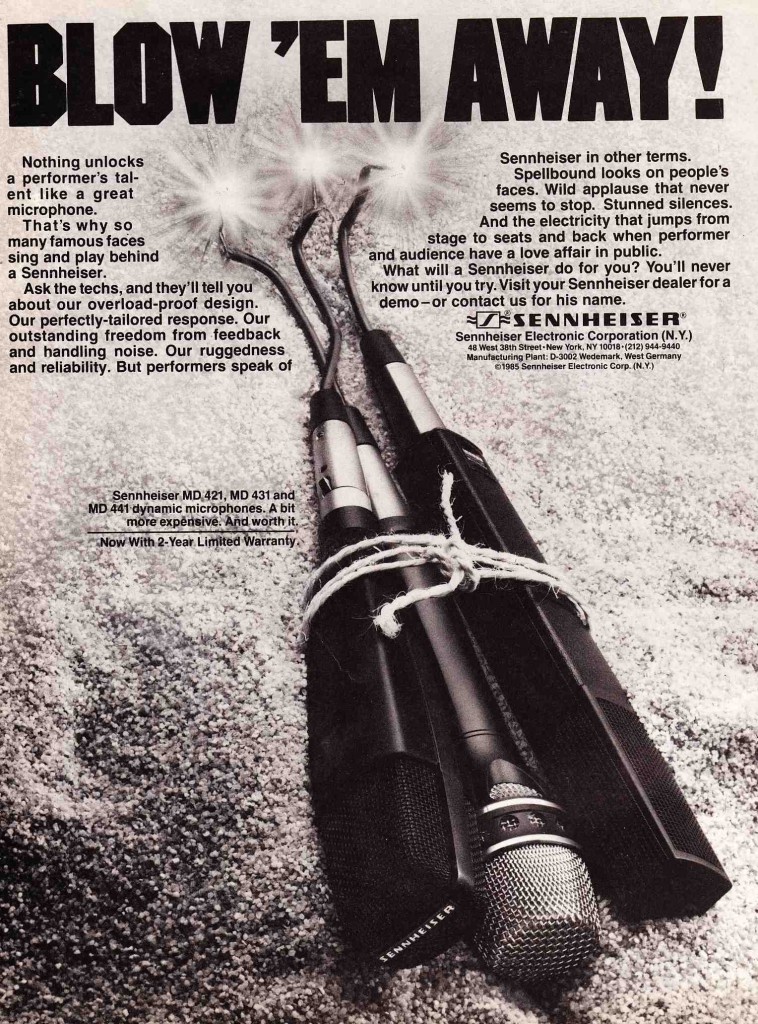 We’ve looked at a lot of 1960s and 1970s Sennhesier 421 ads on this site; here is an 80’s iteration, complete with the ‘blackfire’ 441 of the era.
We’ve looked at a lot of 1960s and 1970s Sennhesier 421 ads on this site; here is an 80’s iteration, complete with the ‘blackfire’ 441 of the era.
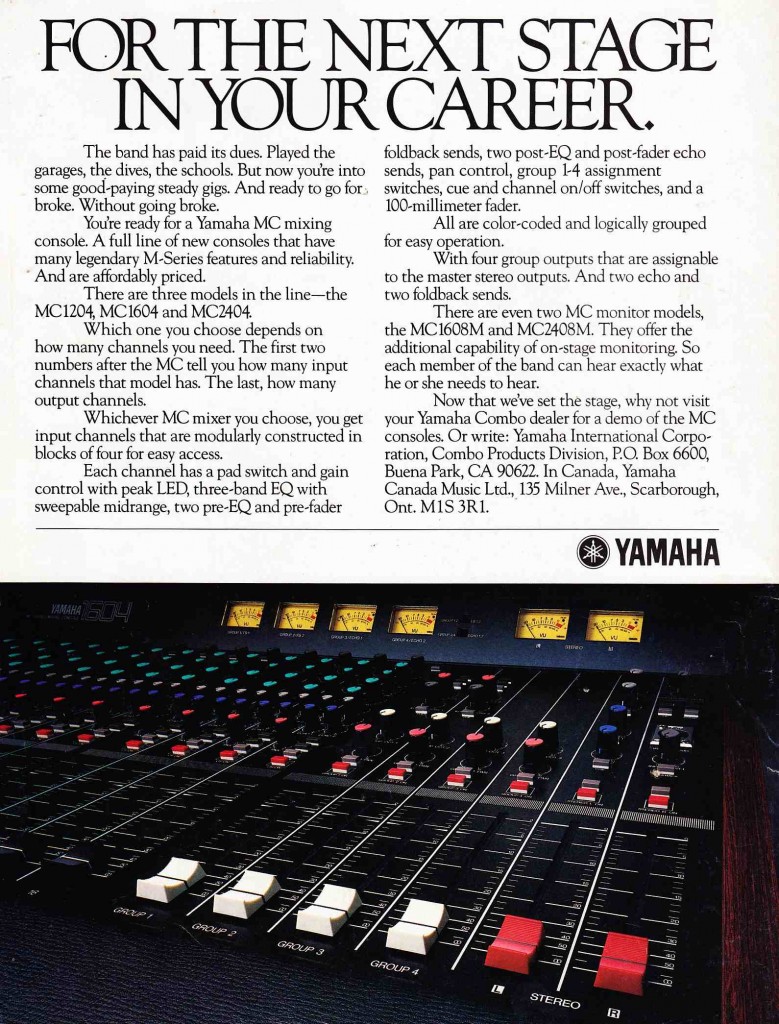 There is a lot of emphasis in the advertising on ‘professional,’ ‘career,’ ‘making it happen,’ etc. Not sure if we can read this as an appearance of the unavoidable-in-the-1980’s ‘yuppie’ zeitgeist but it certainly stands out today as odd language to find in a musician (artist) space, which we generally populate with romantic ‘creative’ and ‘expressive’ concepts.
There is a lot of emphasis in the advertising on ‘professional,’ ‘career,’ ‘making it happen,’ etc. Not sure if we can read this as an appearance of the unavoidable-in-the-1980’s ‘yuppie’ zeitgeist but it certainly stands out today as odd language to find in a musician (artist) space, which we generally populate with romantic ‘creative’ and ‘expressive’ concepts.
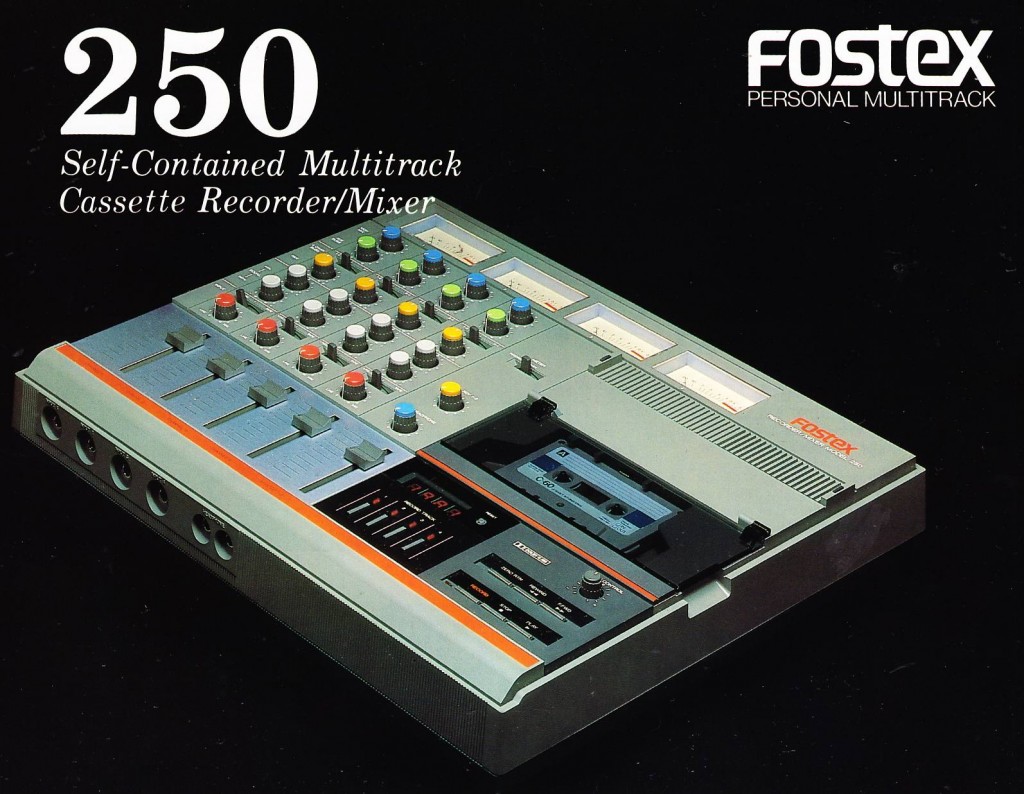 Fostex week continues at PS dot com. Download five pages of original FOSTEX product information on the 250 and 250AV ‘four-tracks’:
Fostex week continues at PS dot com. Download five pages of original FOSTEX product information on the 250 and 250AV ‘four-tracks’:
DOWNLOAD: Fostex250
I’ve never used one of these machines personally. Anyone?
The 250AV, btw, is the same as the 250, except that it runs at 1.875ips (the same as a regular consumer tape deck); the intent was to simplify multi-track bouncing in audio-visual post-production situations. Read the product sheet and you will see what i mean. It also boasts a 5db lower crosstalk spec than the 250; FOSTEX claims that this allows a pulse (sync) tone can be placed on one the tracks to drive other machines without the pulse -sound getting into your other 3 tracks.
 Download the 4pp circa 1984 Fostex Full Line (condensed) catalog:
Download the 4pp circa 1984 Fostex Full Line (condensed) catalog:
DOWNLOAD: Fostex1984
Fostex was the yin to Tascam’s yang in the home-recording 80s. What does this mean? What is the sound of 4 tracks of noise reduction with no recorded signal? ANYway… I always imagined Fostex equipment to be just a little bit flimsier and crappier than the similar Tascam products… although in retrospect I think they were about equal. The two pieces of ‘pro’ tascam/fostex gear that i owned back-to-back (balanced-input CDR recorders) both failed completely in 2 years each, so clean slate there.
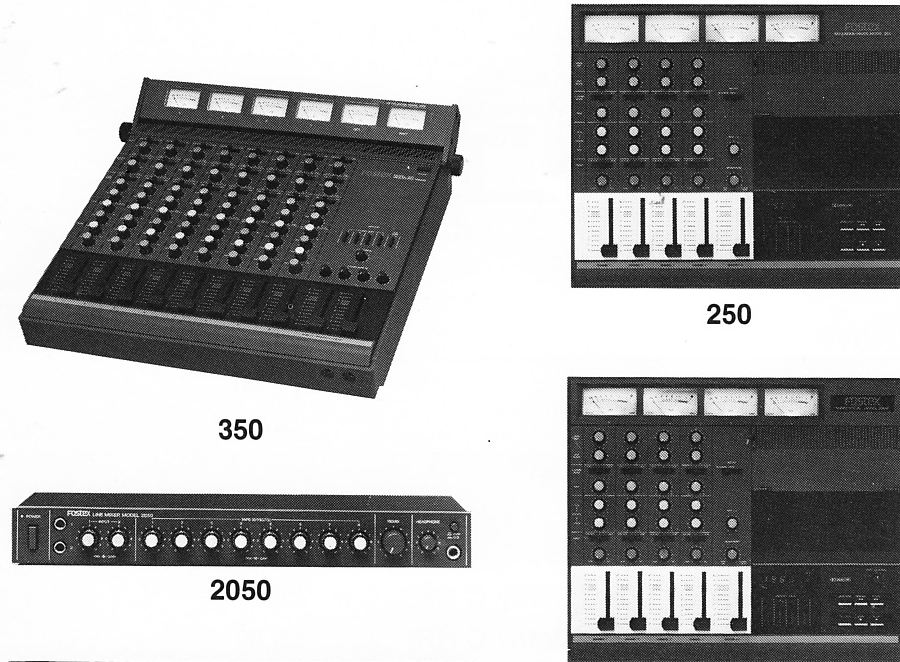 Fostex 250 cassette 4-track machine
Fostex 250 cassette 4-track machine
Is someone out there collecting examples of every 4-track machine from the 80s? (the pre-ADAT era)? Likely. If you are that weirdo, blogging away about the relative merits of each, do drop a line.
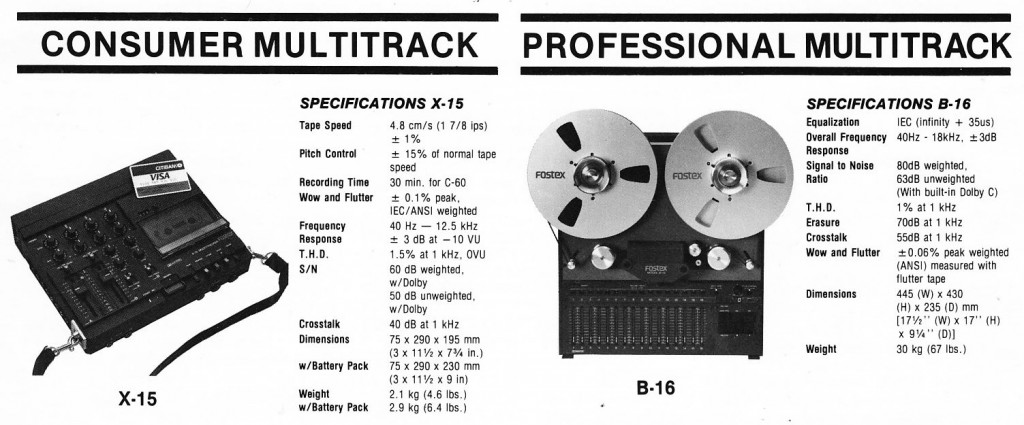 I seem to have a massive amount of early-80s FOSTEX ephemera piled up here, so I guess this gonna be FOSTEX week at PS. First stop: The B16 1/2″ 16-track machine.
I seem to have a massive amount of early-80s FOSTEX ephemera piled up here, so I guess this gonna be FOSTEX week at PS. First stop: The B16 1/2″ 16-track machine.
